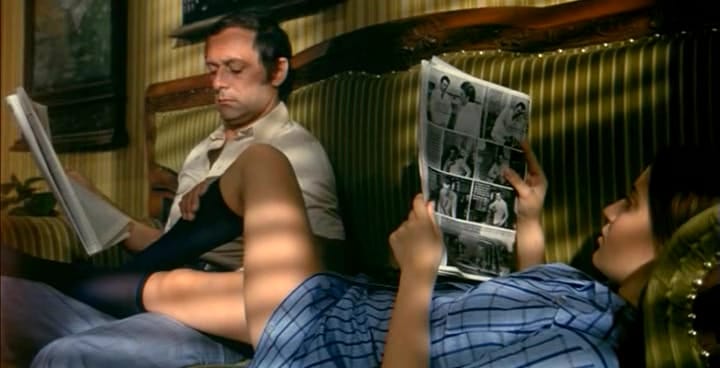
La seduzione (1973) sees Italian auteur Fernando Di Leo moving outside of the confines of his beloved poliziotteschi and giallo genres to try his hand at the erotic drama. The premise of La seduzione comes from a novel by Ercole Patti that, at least in its movie form, strongly resembles Nabokov’s Lolita. Di Leo reimagines this narrative as an extension of the macho fantasies in his poliziotteschi and giallo pictures. Di Leo has to negate the subversive social commentaries of Patti and Nabokov simply because he seems unable to imagine a legitimate female perspective of these narrative tropes.
La seduzione opens with Giuseppe (Maurice Ronet) returning to Sicily from Paris where he has been living and working for fifteen years as a journalist. He’s returned home to seek out his first love, the widowed Caterina (Lisa Gastoni) and rekindle their once ill fated romance. All is going well for the couple despite the useless advice of Giuseppe’s oafish clown of a friend Alfredo (Pino Caruso) when Caterina’s teenaged daughter Graziella (Jenny Tamburi) catches Giuseppe’s eye. The two flirt, advancing toward one another until things escalate out of control and Caterina catches them in bed together.
For its first act, La seduzione is pure romance as the estranged couple rediscovers their lost love. Di Leo’s direction is restrained, relying on the chemistry of Ronet and Gastoni to be affecting. This proves so successful that Giuseppe’s sudden sexual interest in Graziella is totally unexpected. Of course, that is the point. Di Leo doesn’t want the audience to see Giuseppe’s affair with Caterina’s daughter coming. The odd thing is, once Giuseppe and Graziella begin to flirt, La seduzione becomes an unabashed celebration of a very specific and problematic misogynist fantasy.
Di Leo’s camera fetishizes the teenaged body of Graziella in the same way as Giuseppe’s gaze but without offering any counterpoint or juxtaposition. Likewise, Alfredo describes Graziella as “wanting it really bad” which only seems to embolden Giuseppe’s sexual advances. Di Leo lingers on scenes of this taboo affair as they find time alone to caress and cuddle.
When Caterina finds them out Di Leo’s macho fantasy bursts, overcome with Caterina’s rage. Di Leo gives Caterina all of the empathy he can, refocusing the film on her character for as long as he can endure. Then the focus of La seduzione shifts again and asks the viewer to pity Giuseppe, ignore Graziella’s victimization, and to find frustration in Caterina’s outrage. Surprisingly Caterina’s dialogue in this portion of La seduzione still has her making the most sense as she storms about her disappointment with herself and defends her daughter stating, rightly so, that Graziella is just a kid. Di Leo, however, continues to frame Giuseppe as the injured party.
La seduzione takes this further when Giuseppe decides to carry on with Graziella’s school friend. Again Di Leo celebrates this macho fantasy as the natural continuation of the tough guy cop and gangster personas in his other films. Di Leo follows this tradition until the very end of La seduzione when Caterina guns down Giuseppe because in a Fernando Di Leo film no one this macho can live.
The reason why this kind of romantic posturing is so much more problematic in La seduzione than in Di Leo’s poliziotteschi films is that La seduzione isn’t dealing in mythic archetypes or larger than life heroes and villains. There’s a domestic immediacy in La seduzione that simply cannot exist in either a giallo or poliziotteschi film. La seduzione has all the morality of a second-rate porno but with the prestige and self-seriousness of Kubrick’s Lolita (1963).
